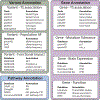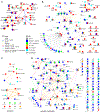Whole-exome sequencing identifies genes associated with Tourette's disorder in multiplex families
- PMID: 33837273
- PMCID: PMC8501157
- DOI: 10.1038/s41380-021-01094-1
Whole-exome sequencing identifies genes associated with Tourette's disorder in multiplex families
Abstract
Tourette's Disorder (TD) is a neurodevelopmental disorder (NDD) that affects about 0.7% of the population and is one of the most heritable NDDs. Nevertheless, because of its polygenic nature and genetic heterogeneity, the genetic etiology of TD is not well understood. In this study, we combined the segregation information in 13 TD multiplex families with high-throughput sequencing and genotyping to identify genes associated with TD. Using whole-exome sequencing and genotyping array data, we identified both small and large genetic variants within the individuals. We then combined multiple types of evidence to prioritize candidate genes for TD, including variant segregation pattern, variant function prediction, candidate gene expression, protein-protein interaction network, candidate genes from previous studies, etc. From the 13 families, 71 strong candidate genes were identified, including both known genes for NDDs and novel genes, such as HtrA Serine Peptidase 3 (HTRA3), Cadherin-Related Family Member 1 (CDHR1), and Zinc Finger DHHC-Type Palmitoyltransferase 17 (ZDHHC17). The candidate genes are enriched in several Gene Ontology categories, such as dynein complex and synaptic membrane. Candidate genes and pathways identified in this study provide biological insight into TD etiology and potential targets for future studies.
© 2021. The Author(s), under exclusive licence to Springer Nature Limited.
Figures



Similar articles
-
The PNKD gene is associated with Tourette Disorder or Tic disorder in a multiplex family.Mol Psychiatry. 2018 Jun;23(6):1487-1495. doi: 10.1038/mp.2017.179. Epub 2017 Sep 12. Mol Psychiatry. 2018. PMID: 28894297 Free PMC article.
-
Whole-exome sequencing identifies high-confidence genes for tic disorders in a Chinese Han population.Clin Chim Acta. 2024 Jul 15;561:119759. doi: 10.1016/j.cca.2024.119759. Epub 2024 Jun 14. Clin Chim Acta. 2024. PMID: 38880274
-
Molecular Landscape of Tourette's Disorder.Int J Mol Sci. 2023 Jan 11;24(2):1428. doi: 10.3390/ijms24021428. Int J Mol Sci. 2023. PMID: 36674940 Free PMC article.
-
Functional Evaluations of Genes Disrupted in Patients with Tourette's Disorder.Front Psychiatry. 2016 Feb 9;7:11. doi: 10.3389/fpsyt.2016.00011. eCollection 2016. Front Psychiatry. 2016. PMID: 26903887 Free PMC article. Review.
-
Spontaneous preterm birth: advances toward the discovery of genetic predisposition.Am J Obstet Gynecol. 2018 Mar;218(3):294-314.e2. doi: 10.1016/j.ajog.2017.12.009. Epub 2017 Dec 14. Am J Obstet Gynecol. 2018. PMID: 29248470 Free PMC article. Review.
Cited by
-
Common genetic risk factors in ASD and ADHD co-occurring families.Hum Genet. 2023 Feb;142(2):217-230. doi: 10.1007/s00439-022-02496-z. Epub 2022 Oct 17. Hum Genet. 2023. PMID: 36251081 Free PMC article.
-
Structural Variations Contribute to the Genetic Etiology of Autism Spectrum Disorder and Language Impairments.Int J Mol Sci. 2023 Aug 26;24(17):13248. doi: 10.3390/ijms241713248. Int J Mol Sci. 2023. PMID: 37686052 Free PMC article.
-
Identity-by-descent analysis of a large Tourette's syndrome pedigree from Costa Rica implicates genes involved in neuronal development and signal transduction.Mol Psychiatry. 2022 Dec;27(12):5020-5027. doi: 10.1038/s41380-022-01771-9. Epub 2022 Oct 12. Mol Psychiatry. 2022. PMID: 36224258 Free PMC article.
-
Structural Variants and Implicated Processes Associated with Familial Tourette Syndrome.Int J Mol Sci. 2024 May 25;25(11):5758. doi: 10.3390/ijms25115758. Int J Mol Sci. 2024. PMID: 38891944 Free PMC article.
-
Treatment of Tourette syndrome by acupuncture combined with Chinese medicine based on syndrome differentiation: A review.Medicine (Baltimore). 2023 Jul 21;102(29):e34268. doi: 10.1097/MD.0000000000034268. Medicine (Baltimore). 2023. PMID: 37478233 Free PMC article. Review.
References
-
- Robertson MM, Eapen V, Singer HS, Martino D, Scharf JM, Paschou P et al. Gilles de la Tourette syndrome. Nat Rev Dis Primers 2017; 3: 16097. - PubMed
-
- Scharf JM, Miller LL, Gauvin CA, Alabiso J, Mathews CA, Ben-Shlomo Y. Population Prevalence of Tourette Syndrome: A Systematic Review and Meta-Analysis. Movement Disord 2015; 30(2): 221–228. - PubMed
-
- O’Rourke JA, Scharf JM, Platko J, Stewart SE, Illmann C, Geller DA et al. The familial association of tourette’s disorder and ADHD: the impact of OCD symptoms. American journal of medical genetics Part B, Neuropsychiatric genetics : the official publication of the International Society of Psychiatric Genetics 2011; 156B(5): 553–560. - PMC - PubMed
Publication types
MeSH terms
Substances
Grants and funding
LinkOut - more resources
Full Text Sources
Other Literature Sources
Medical
Molecular Biology Databases

